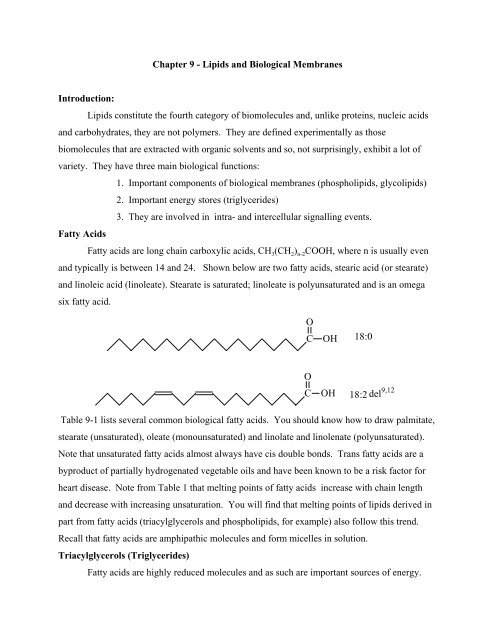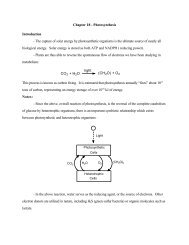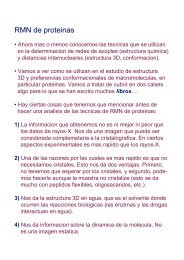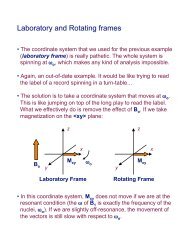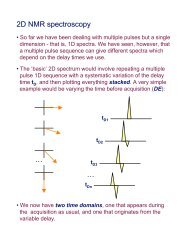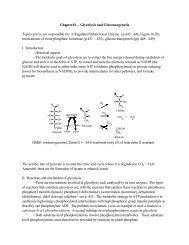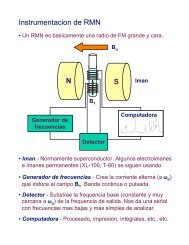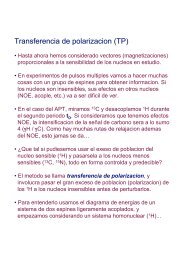Chapter 9 - Lipids and Biological Membranes
Chapter 9 - Lipids and Biological Membranes
Chapter 9 - Lipids and Biological Membranes
Create successful ePaper yourself
Turn your PDF publications into a flip-book with our unique Google optimized e-Paper software.
<strong>Chapter</strong> 9 - <strong>Lipids</strong> <strong>and</strong> <strong>Biological</strong> <strong>Membranes</strong>Introduction:<strong>Lipids</strong> constitute the fourth category of biomolecules <strong>and</strong>, unlike proteins, nucleic acids<strong>and</strong> carbohydrates, they are not polymers. They are defined experimentally as thosebiomolecules that are extracted with organic solvents <strong>and</strong> so, not surprisingly, exhibit a lot ofvariety. They have three main biological functions:1. Important components of biological membranes (phospholipids, glycolipids)2. Important energy stores (triglycerides)3. They are involved in intra- <strong>and</strong> intercellular signalling events.Fatty AcidsFatty acids are long chain carboxylic acids, CH 3 (CH 2 ) n-2 COOH, where n is usually even<strong>and</strong> typically is between 14 <strong>and</strong> 24. Shown below are two fatty acids, stearic acid (or stearate)<strong>and</strong> linoleic acid (linoleate). Stearate is saturated; linoleate is polyunsaturated <strong>and</strong> is an omegasix fatty acid.OCOH18:0OCOH18:2 del 9,12Table 9-1 lists several common biological fatty acids. You should know how to draw palmitate,stearate (unsaturated), oleate (monounsaturated) <strong>and</strong> linolate <strong>and</strong> linolenate (polyunsaturated).Note that unsaturated fatty acids almost always have cis double bonds. Trans fatty acids are abyproduct of partially hydrogenated vegetable oils <strong>and</strong> have been known to be a risk factor forheart disease. Note from Table 1 that melting points of fatty acids increase with chain length<strong>and</strong> decrease with increasing unsaturation. You will find that melting points of lipids derived inpart from fatty acids (triacylglycerols <strong>and</strong> phospholipids, for example) also follow this trend.Recall that fatty acids are amphipathic molecules <strong>and</strong> form micelles in solution.Triacylglycerols (Triglycerides)Fatty acids are highly reduced molecules <strong>and</strong> as such are important sources of energy.
Due to their tendency to form micelles fatty acids are stored as triglycerides, also known as fats,which are fatty acid triesters of glycerol. Tristearin is shown below:OC O CH 2O CH OC OCH 2COTriglycerides are highly insoluble <strong>and</strong> are stored as cellular droplets in adipocytes, or fat cells.Not only are triglycerides more highly reduced than the other main energy stores, carbohydrates,they are also less soluble, hence have less water of hydration associated with them. For thisreason, triglycerides provide about six times the metabolic energy of an equal weight of hydratedglycogen (which, you may recall, is the form in which we store carbohydrate (animal starch)).Melting points of fats depend on the chain length <strong>and</strong> degree of unsaturation of their fattyacids. Tristearin, the major lipid of animal fat, is a solid at room temperature, which you willnotice when you brown ground beef, drain the fat, <strong>and</strong> let it cool down. Vegetable oil, whichcontains unsaturated fatty acids is a liquid at room temperature.GlycerophospholipidsThese are major components of biological membranes. They consist of glycerol + 2 fattyacids + phosphate + R group (figure 9 - 3 b),OROPOCH 2OOHCOCCH 2 OCOwhere the R group is an alcohol, such as ethanolamine, choline, serine, etc. Serine <strong>and</strong> inositolare shown below. See Table 9-2 for a complete list.
HCC CH 2 ONO 2-H 3+SerineOHOH OHOHOHinositolFigure 9-4 shows the structure of a phosphatidyl choline (PC).Other glycerophospholipids are abbreviated PS, PI, PE, etc.Glycerophospholipids, in addition to being important components of biologicalmembranes, as we’ll see in <strong>Chapter</strong> 10, are also important biological surfactants. For example,cellular droplets of triglycerides in adipocytes are surrounded by a monolayer of phospholipid.Also, PC’s, in particular DPPC are important lung surfactants, where they form monolayers onthe surfaces of cells that form the small air spaces of the lungs (alveoli), thereby decreasing thesurface tension, which facilitates breathing (see box 9-1).Phospholipases are enzymes that cleave phospholipids. Various venoms contain
phospholipases. Their action is summarized in Figure 9-5:Note: The hydrolysis products of membrane lipids can lead to the production of signalingmolecules, such as secondary messengers. For example, the production of lyso-PA in bloodplatelets <strong>and</strong> injured cells stimulates cell growth. Also, the action of a phospholipase C leads tothe production of 1,2-diacylglycerol, an intracellular messenger that activates a protein kinase.A plasmalogen is a phospholipid with the fatty acid at C-1 attached via an ether, ratherthan ester linkage, with unsaturation at the ",$ position (ethanolamine, choline <strong>and</strong> serine are themost common head groups).OROPOOH 2 C CHCH 2OOCHC OHCThe vinyl group is easily oxidized, henceplasmalogens may react with oxygen free radicals, thus preventing free-radical damage to othercell constituents.
SphingolipidsThese phospholipids are based on sphingosine, rather than glycerolHCH 3 (CH 2 ) 12 C C CH CHCH 2 OHHOHNH 2- Ceramide = N - fatty acid derivative- Sphingomyelin = (typically) ceramide + Phosphate + choline or ethanolamine- Cerebroside = ceramide + single sugar- Ganglioside = ceramide + oligosaccharideA sphingomyelin is shown below. Sphingomyelins are important membrane components.HOCH 3 (CH 2 ) 12 C C CH CHCH 2 O P OH OH NH OCH 2 CH 2 N(CH 3 ) 3+COCerebrosides <strong>and</strong> gangliosides are glycosphingolipids. Both cerebrosides <strong>and</strong> gangliosides lackphosphate groups; rather, they are both contain mono- (cerebrosides) or complex saccharides(gangliosides) bonded to a ceramide moiety via an O-glycosidic linkage. A ganglioside is shownin Figure 9-9.
Note: Gangliosides on the external surface of membranes act as specific receptors for certainpituitary hormones that regulate a number of important physiological functions. They are alsoreceptors for certain bacterial toxins, such as cholera toxin. They also appear to function in celcellrecognition, thus are likely involved in growth <strong>and</strong> differentiation, <strong>and</strong> also carcinogenesis.Several genetic disorders of ganglioside breakdown are known, such as Tay-Sachs disease.SteroidsCholesterol (Figure 9-10) is also a major component of animal plasma membranes. TheCholesterol is an amphipathic molecule due to the presence of the hydrophilic OH group.Cholesterol is
the metabolic precursor of steroid hormones:Glucocorticoids, such as cortisol, <strong>and</strong> mineralocorticoids, such as alsosterone, areproduce in the cortex (outer layer) of the adrenal gl<strong>and</strong>. Glucocorticoids affect carbohydrate,protein <strong>and</strong> lipid metabolism. Also affect inflammatory reactions, stress response, etc.Mineralocorticoids regulate excretion of salt <strong>and</strong> water by the kidneys (Figure 9-11).Androgens <strong>and</strong> estrogens affect sexual development <strong>and</strong> function (Figure 9-11)Both <strong>and</strong>rogens <strong>and</strong> estrogens are produced by the testes <strong>and</strong> ovaries, although the testes produceprimarily <strong>and</strong>rogens <strong>and</strong> the ovaries primarily estrogens.Note that hormones are cellular messengers that mediate the coordination of metabolic activityin complex organisms. Steroid hormones are water-insoluble, unlike water-soluble hormonessuch as the catecholamines (produced in the inner portion of the adrenal gl<strong>and</strong> (medulla)), <strong>and</strong>thus bind to <strong>and</strong> are transported through the blood by proteins.Vitamin D is also produced from cholesterol <strong>and</strong> is involved in Ca ++ metabolism. It isproduced from a cholesterol derivative shown below. UV radiation cleaves a bond in the steroidnucleus; subsequent spontaneous rearrangement of double bonds, followed by enzymatichydroxylation (liver) produces the active form, which increases serum Ca ++ concentrations bystimulating uptake of dietary Ca ++ by promoting its absorption in the intestine, <strong>and</strong> also bystimulating its release from bone. Rickets is a nutritional disease caused by insufficient bonemineralization <strong>and</strong> causes stunted growth <strong>and</strong> deformed bones in children. In the early 20 th
century it was shown that rickets could be prevented by including animal fats in the diet.Exposure to sunlight also prevents rickets.Note that excessive intake of vitamin D, like other fat-soluble vitamins, can be dangerousbecause it is retained in body lipids. Excessive intake of vitamin D can lead to vitamin Dintoxification, resulting in bone demineralization, which then becomes fragile, abnormalcalcification of soft tissues, kidney stones <strong>and</strong> failure. High levels of skin pigmentation inpopulations near the equator may be a protection against vitamin D intoxification.UV radiationcleaves hereH 3 CRH 3 CHOHHHVitamin D 2Vitamin D 3H 3 CH 3 CHCH 3CH 3OHHActive vitamin D(1alpha,25-dihydroxycholecalciferol)HOOH
Other <strong>Lipids</strong>Isoprenoids are built from isoprene.H 2 CCH 3CCH CH 2They include coenzyme Q, a component of electron transport (see text, p. 245) <strong>and</strong> fat-solublevitamins such as vitamin A (vision), derived mainly from beta-carotene, vitamin K (bloodclotting) <strong>and</strong> vitamin E (anti-oxidant).EicosanoidsArachidonic Acid (20:4 del 5,8,11,14)(stored as C2 ester of PI <strong>and</strong> other PL)AspirinIntroduce OxygenProstacyclin Prostagl<strong>and</strong>in ThromboxaneProstacyclins, prostagl<strong>and</strong>ins <strong>and</strong> thromboxanes, known collectively as eicosanoids, arehormone-like substances whose cellular response are often mediated by c-AMP, produce avariety of effects: Inflammatory response, production of pain <strong>and</strong> fever, regulation of bloodpressure, induction of blood clotting, control of reproductive functions such as the induction oflabor, regulation of the sleep-wake cycle.Lipid BilayersSeveral classes of the lipids we’ve discussed are amphipathic, such as fatty acids,phospholipids, <strong>and</strong> even cholesterol, whereas others, such as triglycerides, are very hydrophobic.Fatty acids aggregate to form micelles, as we’ve seen. The thermodynamic driving force formicelle formation is primarily the hydrophobic effect (also responsible for the globular nature ofglobular proteins), thus is largely entropic. Recall that )G = )H - T)S, <strong>and</strong> that )G must benegative for spontaneous micelle formation. )H for micelle formation is small (negligible
enthalpic contribution), whereas )S is fairly large <strong>and</strong> positive (entropically favorable). This isbecause water becomes much less structured if it is removed from intimate contact withhydrophobic groups (figure 9-13).Thehydrophobic effect is largely responsible for spontaneous assembly of amphipathicphospholipids into amphipathic, noncovalent strutures as well. Phospholipids, however,spontaneously assemble into bilayers because of the added steric effects of the additionalaliphatic R group. Figure 9-14 demonstrates the steric crowding resulting from the additionalaliphatic “tail.”The crowding is relieved by formation of a bilayer. Bilayer sheets will spontaneously formwater-filled enclosures. 9-15.
Phospholipidbilayers are noncovalent, dynamic structures in which individual lipids are mobile. Types oflipid movement are transverse diffusion (flip-flop), which is slow, <strong>and</strong> lateral diffusion, which ismuch faster. Lateral <strong>and</strong> transverse diffusion are illustrated in Figure 9-16
The hydrophobic core of a phospholipid bilayer present in biological membranes is ratherfluid, with a viscosity similar to that of light machine oil. The aliphatic, hydrophobic tails arethus somewhat mobile, with mobility decreasing toward the phosphate group. The fluidity of thecore is controlled by acyl chain length <strong>and</strong> degree of unsaturation. Chain length decreasesfluidity, unsaturation increases fluidity.Phospholipids undergo a cooperative phase transition as temperature is changed, similarto ice W water. Below the transition temperature the core of the membrane is in a solid-like, orgel state. Above the transition temperature, the lipid acyl groups are much more mobile. Sincethe phospholipids are still constrained to remain within their monolayer, the fluid state is oftencalled a liquid crystal (Figure 9 - 18).Bilayers form barriers to passage of hydrophilic solutes. They are selectivelypermeability, which allows different compositions to be established in cells with respect to theirenvironment, <strong>and</strong> also in the organelles of eukaryotic cells.<strong>Biological</strong> membranes contain proteins as well as lipids. Their functions include:- Mediating transport processes. It is such proteins that allow membranes to beselectively permeable, allowing passage to some solutes, but not others.- Receptors- Energy transduction. Oxidative phosphorylation <strong>and</strong> photosynthesis aremembrane-associated events which involve energy transduction. The mechanisms of the energystorageprocess involve building up gradients, or concentration differences, of protons, hence theneed for a membrane.Membrane ProteinsMembrane proteins are classified as either integral (extracted with detergents), orperipheral (extracted by changing pH, ionic strength). As the names imply, integral proteins areembedded to varying extents in the bilayer, whereas peripheral proteins are superficially boundto the bilayer surface.Integral Membrane ProteinsIntegral membrane proteins are difficult to work with because they tend to aggregate <strong>and</strong>precipitate in solution when removed from their bilayer. Notice that the membrane-spanning
portion of glycophorin (Figure 9-20) consists exclusively of amino acid residues with nonpolar, hydrophobicside chains:Notice also that this is one of three domains, the others being the exterior, C-terminal domain, aswell as the interior, N-terminal domain. As would be expected based on their role in recognitionprocesses, the carbohydrate residues (green diamonds) on this glycoprotein reside in the exteriordomain. The interior domain of glycophorin is alpha helical because of the intramolecular H-bonding that characterizes alpha helices.Figure 10-3 shows a hydropathy plot for glycophorin. A hydropathy is a quantitativemeasure of the hydrophobicity or hydrophilicity of a given amino acid residue, <strong>and</strong> is determinedby partitioning the amino acid between water <strong>and</strong> a hydrophobic solvent such as chloroform.The relative amounts in the organic vs. the aqueous phase gives the free energy of transfer towater. Thus a negative hydrophathy (or free energy of transfer to water) indicates a tendency toseek the aqueous phase, <strong>and</strong> vice versa. In order to reduce “noise,” hydrophathy values areactually averages for about 20 amino acid residues. The portion of the hydropathy plot shaded inred in Figure 10-3 indicates the position of the membrane-spanning portion of glycophorin. Youmay recall that we first encountered hydropathy plots in <strong>Chapter</strong> 6. You should compare Figure9-21 to Figure 6-35, a hydropathic index plot for chymotrypsin, a globular protein. Note thefairly r<strong>and</strong>om distribution of hydropathic indices along the chymotrypsin, which lacks theshaded region in Figure 9-21. What would a hydropathic index plot for Bacteriorhodopsin,which contains seven membrane-spanning alpha helical segments, look like (see below)?
Another example of a membrane protein is bacteriorhodopsin, a 247-residue proteinconsisting of a single polypeptide chain. The membrane-spanning domain of Bacteriorhodopsinconsists of seven alpha helical segments (See Figure 9-22). Bacteriorhodopsin is involved in atransduction event in which absorbed light is converted to the chemical energy of ATP. Theprotein is essentially a light-driven proton pump. The light-absorbing pigment is retinal, derivedfrom vitamin A, <strong>and</strong> is the same light-sensitive element in vision. The structure of retinal,. Anisoprenoid, is shown below:CH 3H 3 C CH 3CH 3 CH 3CHOIf the CHO group is reducedto CH 2 OH, the resulting form is retinol, or vitamin A, which is derived from beta carotene.Notice the presence of a cis double bond between carbons 11 <strong>and</strong> 12. All the others (excludingthat in the ring) are trans. The absorbtion of light induces a cis to trans conversion, resulting in aconformational change in the protein to which retinal is bound that leads to the pumping ofprotons in the case of bacteriorhodopsin <strong>and</strong> vision in the case of rhodopsin (in our eyes). Inbacteriorhodopsin, retinal is bound to a lysine residue via a Shiff’s base.Figure 9-24 (a) (see page 256) illustrates the transmembrane domain of consisting of an
antiparallel beta sheet rolled up into a barrel (beta barrel, p. 256). Note that this arrangement, aswell as alpha helices, satisfies the hydrogen-bonding requirement of transmembrane segments ofmembrane proteins. In this case hydrogen bonds form between str<strong>and</strong>s. Beta barrels occur inporins, channel-forming proteins in the outer membrane of gram-negative bacteria, <strong>and</strong> are alsofound in the outer membranes of eukaryotic mitochondria.Lipid-Linked ProteinsWe’ve seen in previous chapters that carbohydrate can be covalently linked to proteins(via O- or N-linkages) to proteins to form glyoproteins, <strong>and</strong> that carbohydrate can be covalentlylinked to lipids to form glycolipids, such as in gangliosides (O-linkage). <strong>Lipids</strong> can also becovalently linked to proteins to form lipid-linked proteins (as opposed to lipoproteins, which willbe discussed later in the chapter). Cysteine residues are involved in attachment of lipids derivedfrom isoprene units (via thioether linkages) to form prenylated proteins, <strong>and</strong> also in theattachment of fatty acids (either myristate, 14:0, or palmitate, 16:0) via amide (myristate) orthioester (palmitate) linkages.
NHOOC(CH 2 ) 12 CH 3CHCH 2 S C(CH 2 ) 14 CH 3NHOOCH 2Thioester (palmitate)Amide (myristate)isoprene unitthioether linkagecysteineresidueSCH 23 or 4CHN COPprenylated proteinNOCSCH 2CHCOPalmitoylationA third type of lipid-linked proteins is glycosylphosphatidylinositol (GPI) proteins. As the nameimplies, GPI proteins contain carbohydrate (Figure 9-25) <strong>and</strong> thus occur exclusively on theexterior of plasma membranes (whereas fatty acid linked proteins, for example, are typicallyfound in subcellular compartments).
Membrane StructureThe technique of freeze-fracture electron microscopy (EM), in which a membrane isfrozen in liquid nitrogen <strong>and</strong> shattered with a sharp blade, illustrated the bilayer nature ofmembranes.EM studies also revealed that the interior face of each monolayer (leaflet) is studded withglobular particles that are integral membrane proteins.The fluid mosaic model of a plasma membrane was proposed by Singer <strong>and</strong> Nicholson in1972, <strong>and</strong> is illustrated in Figure 9-26.
This model incorporates several features we’ve already talked about, including the presence ofperipheral <strong>and</strong> integral proteins, a fluid phospholipid core that allows integral proteins to floatlike icebergs on the two-dimensional phospholipid “sea,” carbohydrate attached either to proteinor lipid on the outer leaflet, cholesterol penetrating the bilayer in order to stabilize it, etc. Anumber of clever experiments have been conducted to illustrate the fluidity of the membrane <strong>and</strong>its effect on lateral diffusion. Photobleaching, for example, consists of attaching a fluorescentgroup to a membrane component, then focusing an intense laser beam on a small portion of themembrane, thereby effectively “bleaching” the fluorescence in that area. The observation thatfluorescence is quickly recovered in the bleached area indicates rapid lateral diffusion of labeledcomponents back into the bleached area (Figure see page 261)Membrane SkeletonRed cell, or erythrocyte, membranes are often used for studies of membrane structure<strong>and</strong> composition because they are easily isolated <strong>and</strong> are fairly simple systems. <strong>Membranes</strong>, orghosts (so called because of their pale appearance) are easily formed by osmotic lysis. Intact redcells are in the form of a biconcave disk (Figure 9-31), which optimizes their oxygen-carryingcapacity. They must be fluid <strong>and</strong> easily deformable in order to squeeze through smallcapillaries. These properties are possible because of the membrane skeleton. Prominent featuresare:
Spectrin, comprised of two similar polypeptide chains, constitutes about 75 % of themembrane skeleton, <strong>and</strong> forms a protein meshwork that underlies the inner leaflet (Figure 9-31).Spectrin is anchored to the membrane by its attachment to ankyrin, which in turn is bound to anintegral membrane protein that functions as an anion channel (CO 2 enters the cell via thischannel as HCO - 3 <strong>and</strong> is carried by the blood to the lungs (Bohr effect)). This figure alsoexplains why integral membrane proteins exhibit different degrees of mobility within themembrane. According to the gates <strong>and</strong> fences model, some integral proteins are firmly attachedto proteins comprising the membrane skeleton, or cytoskeleton, or may be trapped within thespaces by those proteins.Lipid AsymmetryAs we’ve seen, membranes are asymmetric. For example, glycoproteins <strong>and</strong> glycolipidsare typically located on the exterior of the membrane. Studies with phospholipases have shownthat there is also considerably asymmetry with respect to composition. Figure 9-33, for example,indicates that the outer leaflet of the erythrocyte membrane consists largely of PC <strong>and</strong>sphingomyelin, whereas the inner leaflet is richer in PE <strong>and</strong> the acidic PS. Recall that PS is anacidic phospholipid, hence has a net negative charge on its headgroup, thus contributing to themembrane potential.
In eukaryotes, phospholipids are synthesized in the ER. The very slow transverse diffusion tothe outer leaflet is increased about 5 orders of magnitude relative to synthetic bilayers, with theaid of flipases (facilitated diffusion), or via PL translocases (active transport). The action offlipases leads to an equilibrium distribution of PL across the membrane, whereas the latter canmove a phospholipid across a bilayer against a concentration gradient via the action of ATPhydrolysis.In addition to exhibiting transverse asymmetry, as discussed above, membranes are alsolaterally organized, thus possess lateral asymmetry with regard to both lipid <strong>and</strong> proteincomposition. Such asymmetry may be manifested as either domains or microdomains. Divalentcations, such as Ca ++ , which has been known to cause phospholipid segration in syntheticliposomes comprised of different phospholipids, including acidic phospholipids such as PS, maycause clustering of these lipids in biological membranes.One type of microdomain is a lipid raft, appears to consist of closely packedglycosphingolipids <strong>and</strong> cholesterol. Recall that glycosphingolipids occur on the external leafletof plasma membranes. The presence of cholesterol is to fill voids between the acyl chains of theglycosphingolipids caused by their large head groups (glycosphingolipids by themselves cannotform bilayers for this reason). This arrangement results in a more ordered, or crystalline, regionwithin the membrane, <strong>and</strong> these rafts may diffuse laterally within the membrane. The rafts mayfunction as platforms for the assembly of complex intercellular signalling systems. Severalviruses, including influenza, measles Ebola <strong>and</strong> HIV localize to them.Skip sections D <strong>and</strong> E.Problems: 3, 4, 8, 9, 10, 11, 13, 16


